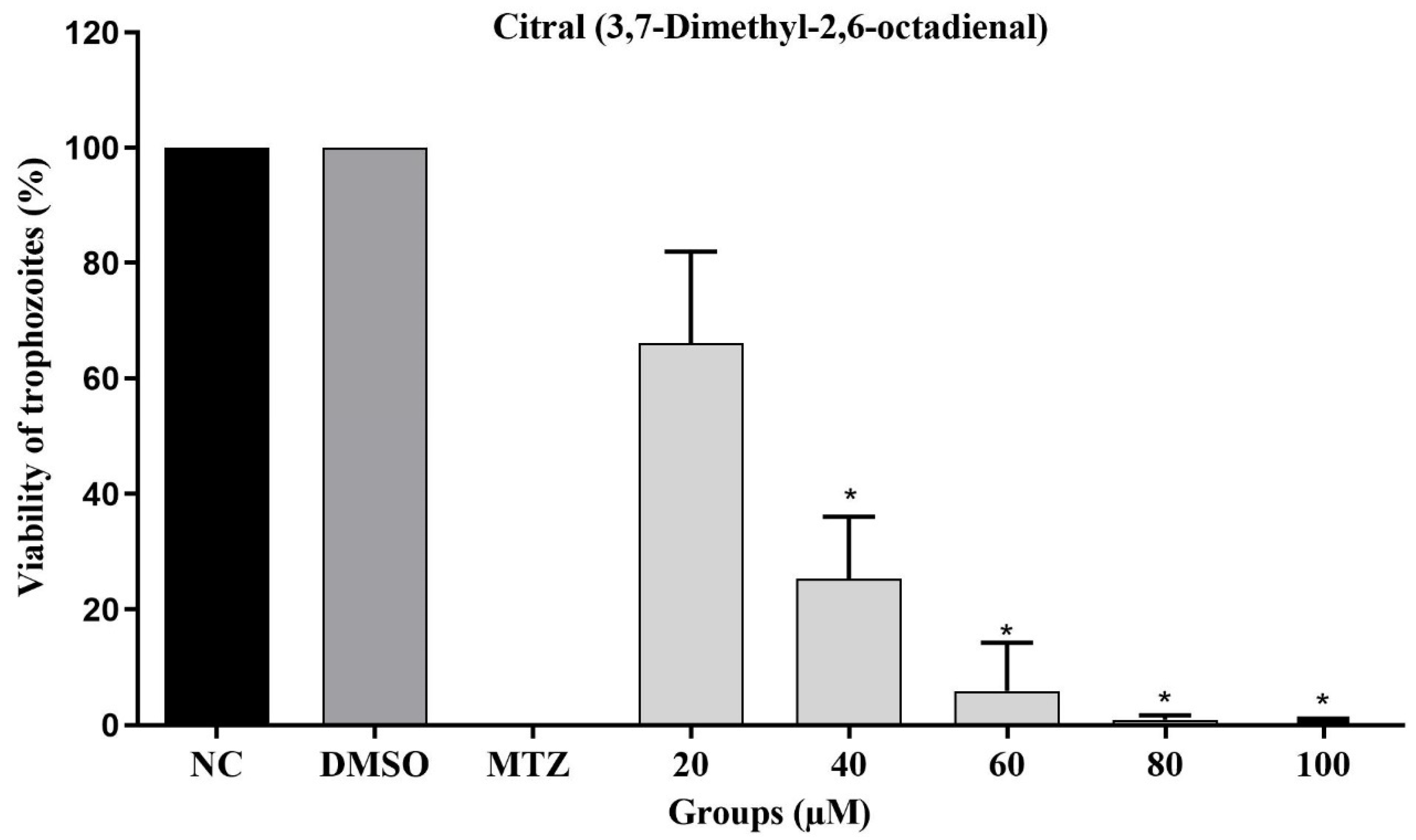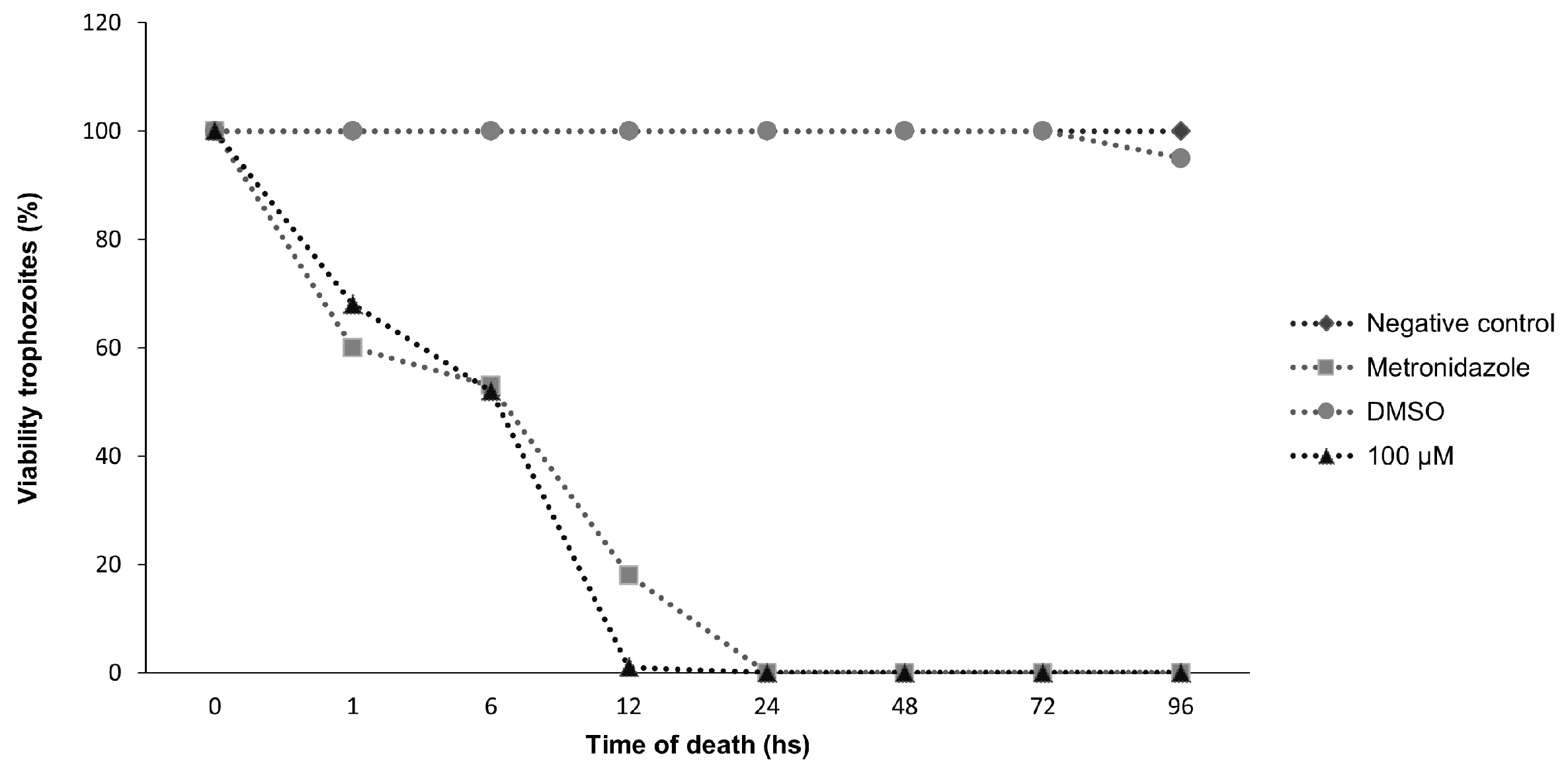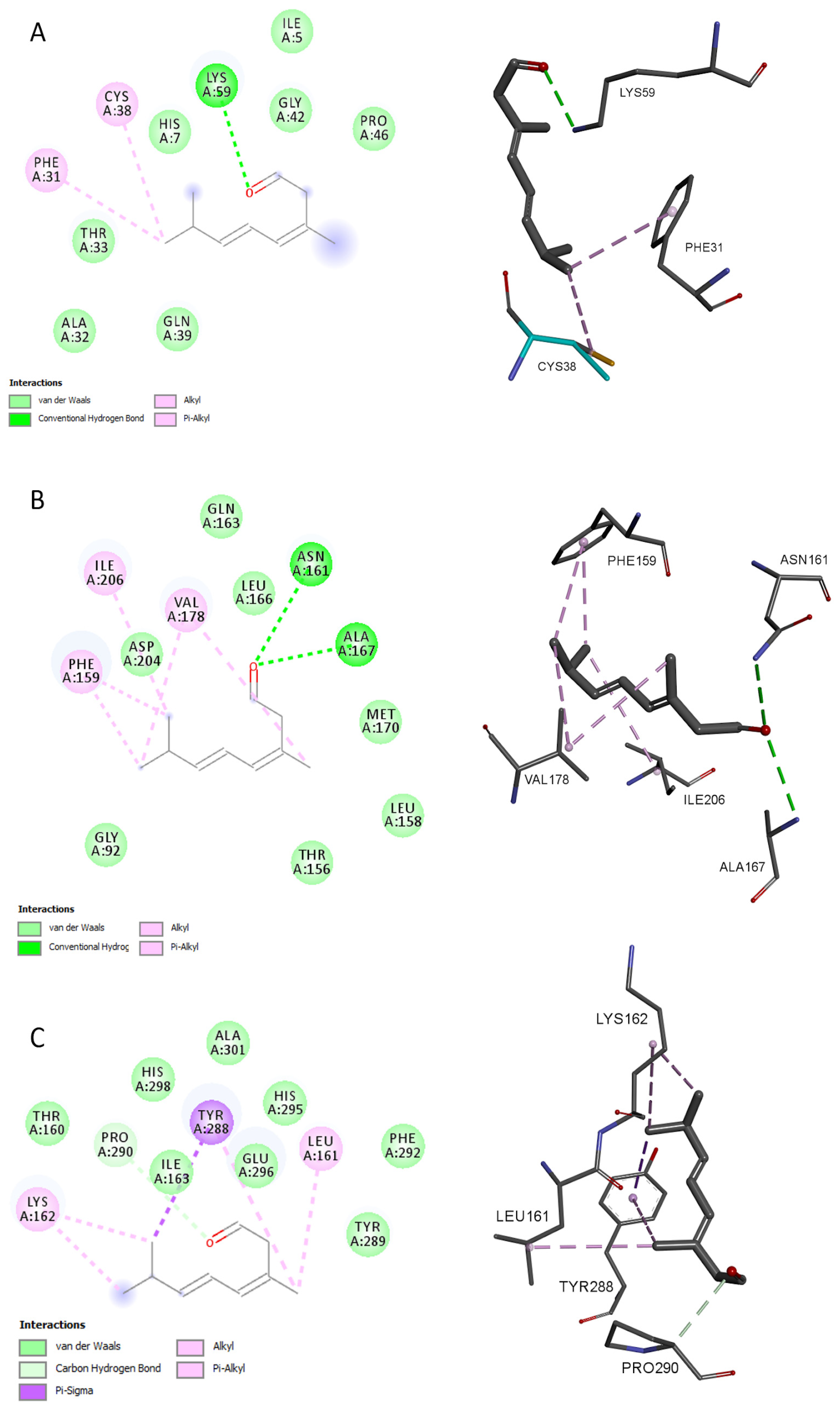First Insights into the Biological Activity and Molecular Docking of Citral (3,7-Dimethyl-2, 6-Octadienal) Against Trichomonas vaginalis
Abstract
1. Introduction
2. Materials and Methods
2.1. Parasite and Cell Culture
2.2. Compounds
2.3. In Vitro Determination of Trichomonacidal Activity
2.4. Nitric Oxide (NOx) Levels
2.5. Molecular Docking
2.6. Statistical Analysis
3. Results
3.1. In Vitro Screening Assay
3.2. Nitric Oxide (NOx) Levels
3.3. Molecular Docking
4. Discussion
5. Conclusions
Author Contributions
Funding
Institutional Review Board Statement
Informed Consent Statement
Data Availability Statement
Conflicts of Interest
References
- World Health Organization. Sexually Transmitted Infections (STIs). Available online: https://www.who.int/news-room/fact-sheets/detail/sexually-transmitted-infections- (accessed on 10 December 2024).
- Wei, X.; Liu, L.; Liu, K.; Qin, X.; Wu, J.; Jiang, L.; Shang, L. Global burden of trichomoniasis: Current status, trends, and projections (1990–2021). Front. Public Health 2025, 13, 1530227. [Google Scholar] [CrossRef] [PubMed]
- Quinlivan, E.B.; Patel, S.N.; Grodensky, C.A.; Golin, C.E.; Tien, H.C.; Hobbs, M.M. Modeling the impact of Trichomonas vaginalis infection on HIV transmission in HIV-infected individuals in medical care. Sex. Transm. Dis. 2012, 39, 671–677. [Google Scholar] [CrossRef]
- Galego, G.B.; Tasca, T. Infinity war: Trichomonas vaginalis and interactions with host immune response. Microb. Cell 2023, 10, 103. [Google Scholar] [CrossRef]
- Cudmore, S.L.; Delgaty, K.L.; Hayward-McClelland, S.F.; Petrin, D.P.; Garber, G.E. Treatment of infections caused by metronidazole-resistant Trichomonas vaginalis. Clin. Microbiol. Rev. 2004, 17, 783–793. [Google Scholar] [CrossRef]
- Narcisi, E.M.; Secor, W.E. In vitro effect of tinidazole and furazolidone on metronidazole-resistant Trichomonas vaginalis. Antimicrob. Agents Chemother. 1996, 40, 1121–1125. [Google Scholar] [CrossRef]
- Muzny, C.A.; Kissinger, P.J. Where do tinidazole and secnidazole fit in with the treatment of trichomoniasis? Sex. Transm. Dis. 2023, 50, e17–e21. [Google Scholar] [CrossRef]
- Secor, W.E. Trichomonas vaginalis: Treatment questions and challenges. Expert Rev. Anti-Infect. Ther. 2012, 10, 107–109. [Google Scholar] [CrossRef]
- De Brum Vieira, P.; Brandt Giordani, R.; Macedo, A.J.; Tasca, T. Natural and synthetic compound anti-Trichomonas vaginalis: An update review. Parasitol. Res. 2015, 114, 1249–1261. [Google Scholar] [CrossRef]
- Kakarla, S.; Ganjewala, D. Antimicrobial activity of essential oils of four lemongrass (Cymbopogon flexuosus Steud) varieties. Med. Aromat. Plant Sci. Biotechnol. 2009, 3, 107–109. [Google Scholar]
- Olayemi, R.F.; Jawonisi, I.O.; Samuel, J.A. Characterization and physico-chemical analysis of essential oil of Cymbopogon citratus leaves. Bayero J. Pure Appl. Sci. 2018, 11, 74–81. [Google Scholar] [CrossRef]
- Baccega, B.; Fenalti, J.M.; De Mello, A.B.; Islabão, Y.W.; Birmann, P.T.; Neis, A.; Giacometi, M.; Monteiro, F.L.; Hubner, S.O.; Vaucher, R.A.; et al. Properties of Compounds Citral and Geraniol on Trichomonas gallinae: Activity in vitro and Cytotoxicity. Iran. J. Parasitol. 2024, 19, 440. [Google Scholar] [CrossRef] [PubMed]
- Ibáñez-Escribano, A.; Nogal-Ruiz, J.J.; Gómez-Barrio, A.; Arán, V.J.; Escario, J.A. In vitro trichomonacidal activity and preliminary in silico chemometric studies of 5-nitroindazolin-3-one and 3-alkoxy-5-nitroindazole derivatives. Parasitology 2016, 143, 34–40. [Google Scholar] [CrossRef] [PubMed]
- Sena-Lopes, A.; Bezerra, F.S.B.; Das Neves, R.N.; De Pinho, R.B.; Silva, M.T.D.O.; Savegnago, L.; Moura, S.; Barcellos, T.; Padilha, F.; Dellagostin, O.; et al. Chemical composition, immunostimulatory, cytotoxic and antiparasitic activities of the essential oil from Brazilian red propolis. PLoS ONE 2018, 13, e0191797. [Google Scholar] [CrossRef] [PubMed]
- Birmann, P.T.; Casaril, A.M.; Hartwig, D.; Jacob, R.G.; Seixas, F.K.; Collares, T.; Savegnago, L. A novel pyrazole-containing selenium compound modulates the oxidative and nitrergic pathways to reverse the depression-pain syndrome in mice. Brain Res. 2020, 1741, 146880. [Google Scholar] [CrossRef]
- Pettersen, E.; Goddard, T.D.; Huang, C.C.; Couch, G.S.; Greenblatt, D.M.; Meng, E.C.; Ferrin, T.E. UCSF Chimera—A visualization system for exploratory research and analysis. J. Comput. Chem. 2004, 25, 1605–1612. [Google Scholar] [CrossRef]
- Hanwell Marcus, D.; Curtis, D.E.; Lonie, D.C.; Vandermeersch, T.; Zurek, E.; Hutchison, G.R. Avogadro: An advanced semantic chemical editor, visualization, and analysis platform. J. Cheminform. 2012, 4, 17. [Google Scholar] [CrossRef]
- Trott, O.; Olson, A.J. AutoDock Vina: Improving the speed and accuracy of docking with a new scoring function, efficient optimization, and multithreading. J. Comput. Chem. 2010, 31, 455–461. [Google Scholar] [CrossRef]
- Onawunmi, G.O.; Yisak, W.A.; Ogunlana, E.O. Antibacterial constituents in the essential oil of Cymbopogon citratus (DC.) Stapf. J. Ethnopharmacol. 1984, 2, 279–286. [Google Scholar] [CrossRef]
- Hammer, K.A.; Carson, C.F.; Riley, T.V. Antimicrobial activity of essential oils and other plant extracts. J. Appl. Microbiol. 1999, 86, 985–990. [Google Scholar] [CrossRef]
- Tchoumbougnang, F.; Zollo, P.A.; Dagne, E.; Mekonnen, Y. In vivo antimalarial activity of essential oils from Cymbopogon citratus and Ocimum gratissimum on mice infected with Plasmodium berghei. Planta Med. 2005, 71, 20–23. [Google Scholar] [CrossRef]
- Boukhatem, M.N.; Ferhat, M.A.; Kameli, A.; Saidi, F.; Kebir, H.T. Lemon grass (Cymbopogon citratus) essential oil as a potent anti-inflammatory and antifungal drugs. Libyan J. Med. 2014, 9, 25431. [Google Scholar] [CrossRef] [PubMed]
- Mamello, S.; Pedro, C.P.; Matsabisa, G.; Oliveira, M.S.; Machado, M. Cytotoxicity Effects and Mechanisms of Action of Cymbopogon citratus Essential Oils Against Pathogens. Pharmacol. Toxicol. 2016, 2, 251–262. [Google Scholar]
- Santoro, G.F.; Cardoso, M.G.; Guimarães, L.G.L.; Freire, J.M.; Soares, M.J. Anti-proliferative effect of the essential oil of Cymbopogon citratus (DC) Stapf (lemongrass) on intracellular amastigotes, bloodstream trypomastigotes and culture epimastigotes of Trypanosoma cruzi (Protozoa: Kinetoplastida). Parasitology 2007, 134, 1649–1656. [Google Scholar] [CrossRef]
- Cardoso, J.; Soares, M.J. In vitro effects of citral on Trypanosoma cruzi metacyclogenesis. Memórias Inst. Oswaldo Cruz 2010, 105, 1026–1032. [Google Scholar] [CrossRef]
- Machado, M.; Pires, P.; Dinis, A.M.; Santos-Rosa, M.; Alves, V.; Salgueiro, L.; Cavaleiro, C.; Sousa, M.C. Monoterpenic aldehydes as potential anti-Leishmania agents: Activity of Cymbopogon citratus and citral on L. infantum, L. tropica and L. major. Exp. Parasitol. 2012, 130, 223–231. [Google Scholar] [CrossRef]
- Leite, M.C.A.; Bezerra, A.P.D.B.; Sousa, J.P.D.; Guerra, F.Q.S.; Lima, E.D. Evaluation of antifungal activity and mechanism of action of citral against Candida albicans. Evid. Based Complement. Alternat. Med. 2014, 1, 78280. [Google Scholar] [CrossRef]
- Raut, J.S.; Karuppayil, S.M. A status review on the medicinal properties of essential oils. Ind. Crops Prod. 2014, 62, 250–264. [Google Scholar] [CrossRef]
- Singh, I. Antimicrobials in Higher Plants: Classification, mode of action and bioactivities. Chem. Biol. Lett. 2017, 4, 48–62. [Google Scholar]
- Cheng, W.; Huang, K.Y.; Huang, P.J.; Hsu, J.H.; Fang, Y.K.; Chiu, C.H.; Tang, P. Nitric oxide maintains cell survival of Trichomonas vaginalis upon iron depletion. Parasit. Vectors 2015, 8, 393. [Google Scholar] [CrossRef]
- Sanches, L.J.; Marinello, P.C.; Panis, C.; Fagundes, T.R.; Morgado-Díaz, J.A.; De-Freitas-Junior, J.C.M.; Cecchini, R.; Cecchini, A.L.; Luiz, R.C. Cytotoxicity of citral against melanoma cells: The involvement of oxidative stress generation and cell growth protein reduction. Tumor Biol. 2017, 39, 1010428317695914. [Google Scholar] [CrossRef]
- Setzer, M.; Byler, K.G.; Ogungbe, I.V.; Setzer, W.N. Natural products as new treatment options for trichomoniasis: A molecular docking investigation. Sci. Pharm. 2017, 85, 5. [Google Scholar] [CrossRef] [PubMed]
- Rinaldo-Matthis, A.; Wing, C.; Ghanem, M.; Deng, H.; Wu, P.; Gupta, A.; Tyler, P.C.; Evans, G.B.; Furneaux, R.H.; Almo, S.C.; et al. Inhibition and structure of Trichomonas vaginalis purine nucleoside phosphorylase with picomolar transition state analogues. Biochemistry 2007, 46, 659–668. [Google Scholar] [CrossRef] [PubMed]
- Moya, I.A.; Westrop, G.D.; Coombs, G.H.; Honek, J.F. Mechanistic studies on the enzymatic processing of fluorinated methionine analogues by Trichomonas vaginalis methionine Y-lyase. Biochem. J. 2011, 438, 513–521. [Google Scholar] [CrossRef]
- Souza, A.C.; Silva, L.K.; Queiroz, T.B.; Marques, E.S.; Hiruma-Lima, C.A.; Gaivão, I.O.; Maistro, E.L. Citral presents cytotoxic and genotoxic effects in human cultured cells. Drug Chem. Toxicol. 2020, 43, 435–440. [Google Scholar] [CrossRef] [PubMed]
- Chaouki, W.; Leger, D.Y.; Liagre, B.; Beneytout, J.L.; Hmamouchi, M. Citral inhibits cell proliferation and induces apoptosis and cell cycle arrest in MCF-7 cells. Fundam. Clin. Pharmacol. 2009, 23, 549–556. [Google Scholar] [CrossRef]
- Liu, Y.; Whelan, R.J.; Pattnaik, B.R.; Ludwig, K.; Subudhi, E.; Rowland, H.; Kapur, A. Terpenoids from Zingiber officinale (Ginger) induce apoptosis in endometrial cancer cells through the activation of p53. PLoS ONE 2012, 7, e53178. [Google Scholar] [CrossRef]
- Ghosh, K. Anticancer effect of lemongrass oil and citral on cervical cancer cell lines. Pharmacogn. Commun. 2013, 3, 41. [Google Scholar] [CrossRef]
- Nordin, N.; Yeap, S.K.; Rahman, H.S.; Zamberi, N.R.; Abu, N.; Mohamad, N.E.; Alitheen, N.B. In vitro cytotoxicity and anticancer effects of citral nanostructured lipid carrier on MDA MBA-231 human breast cancer cells. Sci. Rep. 2019, 9, 1614. [Google Scholar] [CrossRef]
- Nordin, N.; Yeap, S.K.; Zamberi, N.R.; Abu, N.; Mohamad, N.E.; Rahman, H.S.; Alitheen, N.B. Characterization and toxicity of citral incorporated with nanostructured lipid carrier. PeerJ 2018, 6, e3916. [Google Scholar] [CrossRef]




Disclaimer/Publisher’s Note: The statements, opinions and data contained in all publications are solely those of the individual author(s) and contributor(s) and not of MDPI and/or the editor(s). MDPI and/or the editor(s) disclaim responsibility for any injury to people or property resulting from any ideas, methods, instructions or products referred to in the content. |
© 2025 by the authors. Licensee MDPI, Basel, Switzerland. This article is an open access article distributed under the terms and conditions of the Creative Commons Attribution (CC BY) license (https://creativecommons.org/licenses/by/4.0/).
Share and Cite
Mello, A.B.d.; Fenalti, J.M.; Baccega, B.; Wahast Islabão, Y.; Martins, F.O.; Birmann, P.T.; Casaril, A.M.; Barbosa, T.N.; Sena-Lopes, A.; Monteiro, F.L.; et al. First Insights into the Biological Activity and Molecular Docking of Citral (3,7-Dimethyl-2, 6-Octadienal) Against Trichomonas vaginalis. Microbiol. Res. 2025, 16, 96. https://doi.org/10.3390/microbiolres16050096
Mello ABd, Fenalti JM, Baccega B, Wahast Islabão Y, Martins FO, Birmann PT, Casaril AM, Barbosa TN, Sena-Lopes A, Monteiro FL, et al. First Insights into the Biological Activity and Molecular Docking of Citral (3,7-Dimethyl-2, 6-Octadienal) Against Trichomonas vaginalis. Microbiology Research. 2025; 16(5):96. https://doi.org/10.3390/microbiolres16050096
Chicago/Turabian StyleMello, Alexia Brauner de, Juliana Montelli Fenalti, Bruna Baccega, Yan Wahast Islabão, Filipe Obelar Martins, Paloma Taborda Birmann, Angela Maria Casaril, Tallyson Nogueira Barbosa, Angela Sena-Lopes, Francieli Liz Monteiro, and et al. 2025. "First Insights into the Biological Activity and Molecular Docking of Citral (3,7-Dimethyl-2, 6-Octadienal) Against Trichomonas vaginalis" Microbiology Research 16, no. 5: 96. https://doi.org/10.3390/microbiolres16050096
APA StyleMello, A. B. d., Fenalti, J. M., Baccega, B., Wahast Islabão, Y., Martins, F. O., Birmann, P. T., Casaril, A. M., Barbosa, T. N., Sena-Lopes, A., Monteiro, F. L., Savegnago, L., Borsuk, S., Hubner, S. d. O., Farias, N. d. A. d. R., Ibáñez-Escribano, A., & Oliveira, C. B. (2025). First Insights into the Biological Activity and Molecular Docking of Citral (3,7-Dimethyl-2, 6-Octadienal) Against Trichomonas vaginalis. Microbiology Research, 16(5), 96. https://doi.org/10.3390/microbiolres16050096





